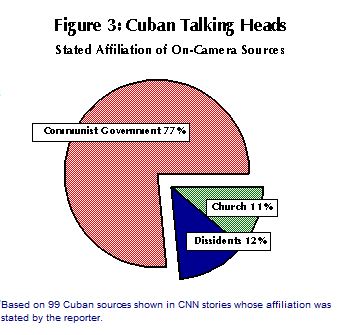Megaphone for a Dictator
Table of Contents:
- Megaphone for a Dictator
- Introduction
- Section 1: Burying the Bad News
- Section 2: Sources Showcased the Party Line
- Conclusion: CNN's Sugarcoated Dictatorship
- Recommendations for Improved Coverage
Section 2: Sources Showcased the Party Line
Besides their choice of topics, another way to grade CNN’s Cuba news is to examine the different individuals the network put before viewers to tell the story. The rationale for establishing a permanent Havana bureau, after all, was that it would allow a greater diversity of opinion than merely passing along the latest pronouncements from the Castro regime, which could easily be done by monitoring the state-controlled Cuban media. On the ground, a reporter could — at least in theory — provide a far more nuanced and comprehensive view of Cuban public opinion.
Cuban talking heads were easily grouped into two categories: sources with an official designation of some kind (as identified by the CNN reporter) and everyday Cubans who were interviewed by CNN as a way to capture public sentiment on an issue.
Communists Dominated “Official” Talking Heads
As Figure 3 shows, Fidel Castro and officials of his government were quoted six times more often than either representatives of the Catholic Church or dissidents, the only other groups which were regularly quoted by CNN at all.

Similarly, Cuba’s Catholic church leaders were given little play on CNN except when issues of religious freedom or the Pope’s visit were addressed. CNN’s Jim Bittermann, for example, paraphrased the comments of the archbishop of Santiago de Cuba at a mass held during the Pope’s trip: “The local archbishop was out-spoken. Many Cubans confused the communist party, he said, with patriotism. And he drew long applause when he told the crowd that the church represented the poor, and the poorest of the poor are those without freedom.”22 Such remarks from Catholic leaders, articulating a very non-communist perspective, were presented on CNN only one-seventh as often as statements from Castro and his spokesmen.
In covering American politics, reporters will try to maintain a balance of viewpoints in their stories by either quoting opposition figures or, if circumstances do not permit it, paraphrasing the other side’s known position. For example, during a special report about Cuba at the time of Pope John Paul II’s visit in January, 1998, Christiane Amanpour summarized the anti-government perspective in a report on Cuba’s bad economy: “Wherever you go, whoever you talk to, you always hear people blame the U.S. embargo for all their woes, but the fact is that Cuba’s rigid socialist structures are as much to blame for this country’s dysfunctional economy. A few openly admit that, and they complain about a growing elite.”23
But balance such as Amanpour’s was rare. Even as CNN’s reporters allowed Castro’s officials to dominate their news, they also did not do much to counter even their most outrageous statements. Thus, after President Clinton signed a bill allowing food and medicine sales to Cuba, a report by Lucia Newman consisted solely of the regime’s perspective. “Cuba says that the new legislation is a farce, a kind of political Trojan horse which appears to improve trade possibilities with Cuba when it, in fact, leaves things the same or, in Havana’s words, worse.... Cuba’s position is, thanks for nothing.”24
Everyday Cubans Were Depicted As Pro-Castro

For example, Lucia Newman found two Cubans to comment on a public ceremony honoring “revolutionary icon” Che Guevara as his body was returned to Cuba 30 years after his death. Plucked from “seemingly endless lines” of mourners, both praised the late communist militant in a story that included no dissent: “This means a lot, because he is our heroic rebel commandant. It’s something historic for the Cuban people,” a man told CNN. “It’s a mixture of sadness, because he is not alive, but also happiness because Che is once again with us,” a woman stated.25

Reporting on Cuban attitudes during the Elian Gonzalez story, Bill Delaney showed only those who argued that life was good under Castro: “If there are children in the world that are happy, they are in Cuba. We have schools, teachers, fun, and there’s no hunger here,” a music teacher told CNN. He was followed by a woman who exclaimed, “I tell you, I have my own children here, and I have my grandchildren, and what they say about Cuba is just untrue.” The third and final talking head was a young student, who declared that “There may be freedoms in other countries, but there is freedom here, too.”27
It’s not unusual for an American reporter to walk down a city street and find a range of opinions on any issue, including disparaging comments about officials from the President on down. By mimicking the same style of person-on-the-street interviews, CNN reporters implicitly contributed to the idea that Cubans are as free to speak as citizens in other countries. At the same time, the heavy slant in favor of communist views only helped bolster Castro’s respectability. Of course, there may not be very many Cubans who wanted to be videotaped by CNN disagreeing with Castro, since the government would surely notice. This is an understandable obstacle to reporting on public opinion in a totalitarian society, but it was one CNN hardly ever mentioned. (See sidebar.)
Instead, the words of the Cuban public were often heard on CNN bolstering the arguments of the dictatorship. During the custody dispute over Elian Gonzalez, many Americans criticized Cuba for forcing parents to send their children to labor camps during the summertime. For a May 26, 2000 report, Lucia Newman found four sources — two 13-year-old girls, a camp official, and a father — all of whom praised the practice.




